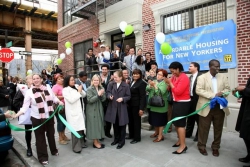Sep
30
2013

Written by Sean Thomas-Breitfeld
When service agencies embrace broader social change and community-level work, it requires a shift in organizational strategy. By strategy, I mean both the motivating vision for the impact the organization will have in the world and also the practices, tactics and choices around staffing that will make the vision a reality. Our latest report in the 5% shifts series examines how two organizations developed and executed strategies to advance their commitment to address problems at both the levels of individual need and community structures.
Oftentimes arriving at a new organizational vision – or just realizing the limitations of an earlier vision – is a valuable process in itself, which is why we’ve developed resources about root causes and learning circles. But the Mutual Assistance Network of Del Paso Heights didn’t stop at learning and reflection. Once they identified the markers of healthy, thriving communities that they wanted to replicate in their own neighborhood – like public, shared spaces that support resident engagement, connection, and health – they shifted their focus away from individuals’ problems and the neighborhood’s deficits. And by weaving the organization into the fabric of the community, they maintained a wide continuum of organizational activities that would engage – and benefit – families in the neighborhood, whether they are struggling or thriving.
For service agencies that decide to take on advocacy and organizing tactics as part of their strategy for making their social change vision a reality, there’s sometimes a tendency to assume that hiring an organizer or creating an advocacy arm will suffice. But I’ve heard many stories from organizational staff and leaders who have felt isolated or sidelined when organizing and advocacy projects aren’t integrated into the entire organization. That’s why the example of Cypress Hills Local Development Corporation is so great. They made their commitment to community activism and engagement real throughout the organization by doing two simple things. They changed their hiring practices to emphasize the organization’s social change mission and vision for all hires because it matters that every staff understands and values leadership development and community organizing as strategies for social change. Also, true to the maxim that ‘what gets measured is what matters; they revamped their staff evaluations to honor the reality that all staff ended up participating in the organization’s advocacy efforts in some way, big or small.
Both organizations continued to address individual needs while also expanding their strategy to address challenges at the community level. Creating such a range of organizational activities is especially critical at a time when the services and safety net for people are under such a brutal attack from state and federal budget cuts. Organizations need to use all of the tools and strategies at their disposal to not just help people survive, but to thrive.
